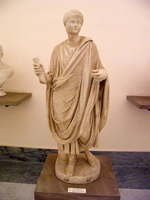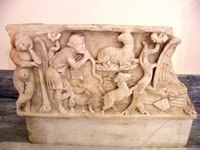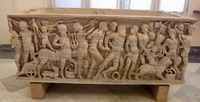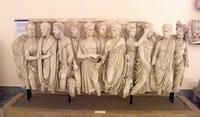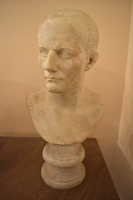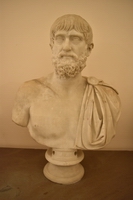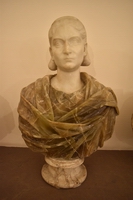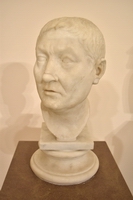Indice dei Musei
presenti in miti3000
Napoli Museo Nazionale - Piano Terra - Collezione Farnese - sala XXVIII
Testo
Sala XXVIII - Ritratti di privati e sarcofagi.
Il ritratto privato costituisce un genere della produzione artistica tipicamente romano. La collezione Farnese annovera un cospicuo gruppo di teste e busti che percorrono il lungo excursus cronologico che va dalla tarda repubblica (I sec. a.C.) alla seconda tetrarchia (primi decenni del IV sec. d.C.) illustrando l’evoluzione dello stile e i valori culturali e sociali espressi da una torma così immediata di auto rappresentazione.
Parallelamente i ritratti costituiscono una testimonianza importante delle mode che si sono avvicendate nel tempo e del rapporto intercorso fra il cittadino e l’autorità imperiale; documentano infatti quel fenomeno che è stato definito dalla ricerca tedesca ‘Zeitgestcht’, ‘volto dell’epoca’, ovvero una forma di assimilazione all’immagine dell’imperatore in carica che riguardava in primo luogo la foggia dei capelli o il taglio della barba, ma che poteva giungere a tradursi in una vera e propria affinità fisionomica.
Il fenomeno coinvolge anche il mondo femminile come attestano i ritratti di donne private che imitano acconciature adottate da membri della famiglia regnante.
Purtroppo non conosciamo la collocazione originaria dei ritratti, per i quali possiamo ipotizzare genericamente un contesto funerario o domestico.
Alla sfera privata appartengono anche i sarcofagi il cui impiego nel costume funerario è di antichissima origine, ma che furono solo occasionalmente utilizzati a Roma, dove per secoli è stata praticata prevalentemente l’incinerazione.
A partire dal II sec. d.C., in seguito ad un mutato orientamento culturale e religioso, che portò a preferire la sepoltura del corpo, si adottò l’uso del sarcofago di marmo, decorato sulle tre facce visibili salvo quella destinata ad essere appoggiata alla parete del monumento funerario.
I motivi decorativi, specie i più ricchi ed elaborati, attingono al patrimonio mitologico classico, rivisitato in chiave allegorica e interpretato alle luce dei nuovi contenuti fìlosofico-religiosi.
Portraits of private individuals and sarcophagi
Private portraits are a typically Roman type of artistic production. The Farnese collection includes a large collection of heads and busts that cover the long chronological arc that stretches from the late republic (I st century BC) to the second tetrachy (first decades of the 4th century AD). It illustrates the evolution of styles and cultural and social values expressed by this immediate form of self-representation.
At the same time, portraits are important evidence for the fashions that changed over time and for the relation-ship that existed between citizen and imperial authority. Indeed, they document the phenomenon that German scholars have termed 'Zeitgesicht', 'character of an era', or rather a manner of assimilation to the image of the current emperor that above all emphasises the hairstyle or the beard, but which can translate itself into a real likeness of the person.
This phenomenon also occurs in the female sphere, as seen by the portraits of private woman that imitate hair styles adopted by member of the ruling family.
Unfortunately we do not know the original position of the portraits. A generic funerary or domestic context can be suggested for them.
Sarcophagi also belong to the private sphere. Their use in funerary customs has an ancient origin, but they were only used occasionally at Rome, where for centuries, for the most part, cremation was practiced.
The use of marble sarcophagi was adopted from the 2nd century AD on, following changes in the cultural and religious customs that eventually led to preferring the burial of bodies. These were decorated on the three visible facades, leaving the one facing the supporting wall of the funerary monument undecorated.
The decorative motifs, especially the richest and most elaborate, draw on the tradition of classical mythology, revisited in allegorical ways and interpreted in light of new philosophical And religious content.
Posiziona il mouse sulle immagini per avere più informazioni.



